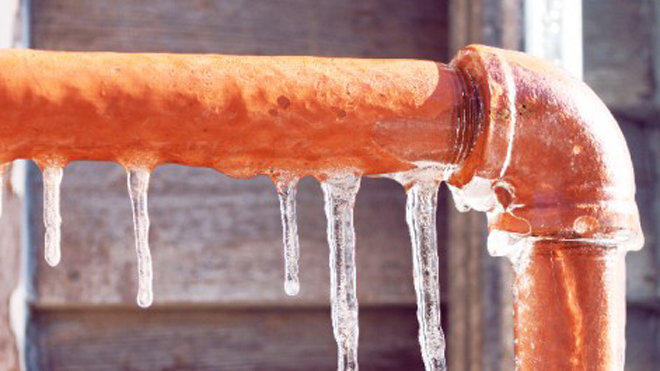Prevent Frozen Plumbing in Cold Weather: Professional Tips
Prevent Frozen Plumbing in Cold Weather: Professional Tips
Blog Article
The article which follows in relation to Helpful Tips to Prevent Frozen Pipes this Winter is exceedingly engaging. Check it out yourself and decide what you think about it.

Cold weather can damage your pipes, specifically by freezing pipelines. Below's just how to stop it from taking place and what to do if it does.
Intro
As temperature levels decrease, the danger of frozen pipes rises, possibly causing expensive repair work and water damage. Recognizing exactly how to avoid icy pipelines is important for property owners in cool environments.
Understanding Icy Pipes
What creates pipes to ice up?
Pipes ice up when exposed to temperature levels below 32 ° F (0 ° C) for expanded periods. As water inside the pipelines ices up, it expands, taxing the pipe walls and possibly causing them to rupture.
Threats and damages
Frozen pipes can bring about water supply interruptions, property damage, and costly repair services. Ruptured pipelines can flooding homes and create extensive structural damage.
Signs of Frozen Pipeline
Determining icy pipelines early can avoid them from breaking.
Just how to recognize icy pipelines
Try to find reduced water flow from faucets, unusual smells or sounds from pipes, and visible frost on revealed pipelines.
Prevention Tips
Insulating vulnerable pipelines
Wrap pipelines in insulation sleeves or utilize warm tape to protect them from freezing temperature levels. Focus on pipelines in unheated or outside locations of the home.
Heating techniques
Maintain indoor areas sufficiently heated, particularly locations with plumbing. Open up cabinet doors to enable cozy air to distribute around pipelines under sinks.
Protecting Outside Pipes
Yard hose pipes and outside taps
Separate and drain garden hoses before winter months. Mount frost-proof spigots or cover outdoor taps with protected caps.
What to Do If Your Pipelines Freeze
Immediate activities to take
If you think icy pipes, maintain faucets open to soothe pressure as the ice thaws. Use a hairdryer or towels taken in hot water to thaw pipelines slowly.
Long-Term Solutions
Architectural modifications
Consider rerouting pipes away from outside wall surfaces or unheated areas. Include added insulation to attic rooms, basements, and crawl spaces.
Updating insulation
Buy top quality insulation for pipelines, attic rooms, and wall surfaces. Proper insulation helps preserve constant temperatures and minimizes the risk of icy pipes.
Final thought
Avoiding icy pipes requires aggressive procedures and quick reactions. By recognizing the causes, indicators, and safety nets, home owners can secure their pipes during winter.
Helpful Tips to Prevent Frozen Pipes this Winter
UNDERSTANDING THE BASICS: WHY PIPES FREEZE AND WHY IT’S A PROBLEM
Water freezing inside pipes is common during the winter months, but understanding why pipes freeze, and the potential problems it can cause is crucial in preventing such incidents. This section will delve into the basics of why pipes freeze and the associated problems that may arise.
THE SCIENCE BEHIND FROZEN PIPES
When water reaches freezing temperatures, it undergoes a physical transformation and solidifies into ice. This expansion of water as it freezes is the primary reason pipes can burst. As the water inside the pipe freezes, it expands, creating immense pressure on the walls. If the pressure becomes too great, the pipe can crack or rupture, leading to leaks and water damage.
FACTORS THAT CONTRIBUTE TO PIPE FREEZING
Low Temperatures: Extremely cold weather, especially below freezing, increases the risk of pipes freezing. Uninsulated or Poorly Insulated Pipes: Pipes located in unheated areas, such as basements, crawl spaces, or attics, are more prone to freezing. Insufficient insulation or lack of insulation altogether exacerbates the problem. Exterior Wall Exposure: Pipes running along exterior walls are susceptible to freezing as they encounter colder temperatures outside. Lack of Heating or Temperature Regulation: Inadequate heating or inconsistent temperature control in your home can contribute to frozen pipes. PROBLEMS CAUSED BY FROZEN PIPES
- Pipe Bursting: As mentioned earlier, the expansion of water as it freezes can cause pipes to burst, resulting in significant water damage.
- Water Damage: When pipes burst, it can lead to flooding and water damage to your property, including walls, ceilings, flooring, and personal belongings.
- Structural Damage: Prolonged exposure to water from burst pipes can compromise the structural integrity of your home, leading to costly repairs.
- Mold and Mildew Growth: Excess moisture from water damage can create a favorable environment for mold and mildew growth, posing health risks to occupants.
- Disrupted Water Supply: Frozen pipes can also result in a complete or partial loss of water supply until the issue is resolved.
WHY CERTAIN PIPES ARE MORE PRONE TO FREEZING
- Location: Pipes located in unheated or poorly insulated areas, such as basements, crawl spaces, attics, or exterior walls, are at higher risk of freezing.
- Exterior Pipes: Outdoor pipes, such as those used for irrigation or exposed plumbing, are particularly vulnerable to freezing as they are directly exposed to the elements.
- Supply Lines: Pipes that carry water from the main water supply into your home, including the main water line, are critical to protect as freezing in these lines can affect your entire plumbing system.
- Underground Pipes: Pipes buried underground, such as those connected to sprinkler systems or outdoor faucets, can be susceptible to freezing if not properly insulated.
https://busybusy.com/blog/helpful-tips-to-prevent-frozen-pipes-this-winter/

Hopefully you enjoyed reading our piece about How to Prevent Your Pipes From Freezing. Thank you so much for taking a few minutes to read our piece. Be sure to take a moment to share this entry if you enjoyed reading it. Thank you so much for your time invested reading it.
Make An Appointment Report this page